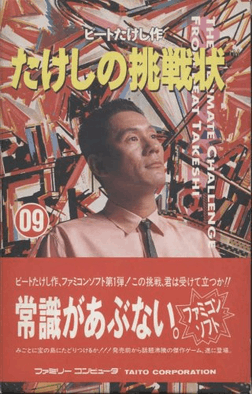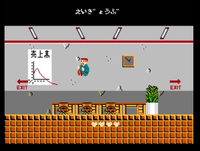Takeshi no Chōsenjō
| Takeshi no Chōsenjō | |
|---|---|
 Box art of Takeshi no Chōsenjō. | |
| Developer(s) | Taito Corporation |
| Publisher(s) | Taito Corporation |
| Designer(s) | Takeshi Kitano |
| Platform(s) | Famicom, iOS, Android |
| Release |
Famicom
|
| Genre(s) | Platform game |
| Mode(s) | Single player |
Takeshi no Chōsenjō (たけしの挑戦状, lit. Takeshi's Letter of Challenge), officially translated as The Ultimate Challenge from Beat Takeshi,[1] is a Japanese action-adventure video game for the Family Computer (known internationally as the Nintendo Entertainment System) developed by Taito Corporation. Though other video games bearing the names of Japanese celebrities had been developed prior to Takeshi no Chōsenjō, comedian-turned actor and film director Takeshi Kitano (Beat Takeshi) was the first celebrity to actively contribute to the video game's development. The packaging contains several warnings that the game should not be attempted with conventional gaming skills, and the player must complete numerous near-impossible tasks in order to finish the game. It was released only in Japan on December 10, 1986.
The iOS and Android version titled Chōsenjō From Beat Takeshi (挑戦状 From Beat Takeshi) was released in Japan on August 15, 2017.
Gameplay

On the surface, Takeshi no Chōsenjō is a side-scrolling adventure game, where the player character can wander the streets and buildings of Tokyo, and later the islands of the South Pacific. Various people and shop-owners can be spoken with, and frequently attacked if the player so chooses.
Kitano incorporated many of his unique and controversial ideas into the game. For instance, the player can beat up a yakuza gangster at a pachinko gambling establishment, and take the yakuza's money to exchange for prizes. The player can use a hang-glider to fly over into a strange land called the "Red Country" (an amalgam between the Soviet Union and Nazi Germany). The player can gain access to the Red Country if they pass over the four other islands, but a huge mountain blocks the way into the country, and the player will be forced to crash into either the mountain or the ground, resulting in an automatic game over screen. There is also a choice on the password-entry screen ("Punch the old man") which results in an automatic game over, even when the player has not even started the game. Other in-game events include: a game over screen where the player's character is given a funeral, singing karaoke at a pub (using the second-controller's built-in microphone), the main character divorcing his wife and paying a settlement, beating up yakuza, or even punching the main character's wife and children (presumably to death).
The game's plot, where a despondent salaryman seeks to find a hidden treasure on an island, is introduced as having been created by Kitano while he was drunk at a bar;[2] however, Kitano himself explains that the plot was solely the result of an hour-long talk at a café near his production company.[3]
Development and reception
The game was originally planned as a Famicom version of Kitano's television show, Takeshi's Castle, before Kitano contacted the game designers about ideas for a new game. The game's basis of being able to exert violence on all characters is similar to that of the Grand Theft Auto series. However, many of Kitano's ideas were rejected either because of the limitations of the Famicom game system, or because the content was not suitable for young children. Two more games bearing Kitano's name were developed after Takeshi no Chōsenjō (Takeshi no Sengoku Fūunji and Family Trainer Totsugeki! Fūun Takeshijō) but Kitano himself was not involved in the development of either of these later games. Though Kitano was involved in a scandal concerning the Japanese gossip magazine Friday (see ja:フライデー襲撃事件) on December 9, 1986, a day before the game's release, Takeshi no Chōsenjō was released as scheduled the following day. Two television commercials were created to advertise the game; one where Kitano is singing karaoke while playing the game, and another where he yells "Come out!" at the microphone in the Famicom's second controller to pull up a treasure map on the game screen. Both commercials are hints for completing the game.[2] According to a Taito Corporation source, 800,000 copies were sold.[2] (Many sources mistranslate the Japanese video as 80,000 copies sold.)
The game placed first in Famitsu magazine's kusoge (crap game) ranking, and is often referred to as one of the worst video games of all time. According to video game researchers Wilson and Sicart,
Takeshi no Chousenjou stands out as an especially outrageous example of abusive game design because Kitano leveraged his fame to sucker players into buying the game (...) Notably, the majority of these players were children – the very audience least equipped to understand Kitano's cruel humor.[4]
On the other hand, it left a strong impact on some critics, and in 2007, it was nominated for the 2007 Retro Game Award at the Tokyo Game Show, along with Spelunker, Adventure Island, and Ghosts 'n Goblins (Super Mario Bros. won the award).[5]
See also
References
- ↑ Ashcraft, Brian (2010-08-10). "Beat Takeshi Hates Games, Computers And Email (What About Twitter?)". Kotaku. Retrieved 2015-10-06.
- 1 2 3 Fuji Television, Game Center CX, Season 1, Episode 1
- ↑ TV Asahi, Beat Takeshi no Konna Hazu-dewa!!, aired July 12, 2003
- ↑ Wilson, Douglas; Sicart, Miguel (2010). Now it's personal: on abusive game design (PDF). Proc. International Academic Conference on the Future of Game Design and Technology. ACM.
- ↑ "TGS 「レトロゲーム・アワード2007」大賞は『マリオ』! 生みの親・宮本氏の生プレイも!!". Archived from the original on 2011-07-18. Retrieved 2008-04-09.